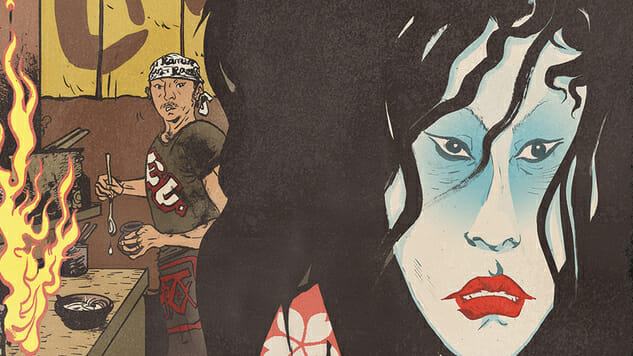Seeing Ghosts: Joel Rose on Anthony Bourdain’s Appetite for Horror Stories
Bourdain’s Hungry Ghosts Co-Writer Reflects on the Berger Books/ Dark Horse Comics Series
Main Art by Paul Pope
With the collected edition of Hungry Ghosts hitting bookstores today from publisher Dark Horse Comics and Berger Books, Paste invited the late Anthony Bourdain’s friend and frequent collaborator Joel Rose to write a bit about Bourdain and their work together on the series. His essay follows.
I didn’t ask questions when he came to me wanting to do ghost stories. When he mentioned the idea for Hungry Ghosts, wanted to know if I wanted to do it, I said yes, straight up. I never asked myself why he wanted to go there. To a place I certainly knew nothing about. What did he want with horror? I didn’t know. What attraction did ghost stories have for him? Didn’t ask that either. What was he looking for? Never went there.
But now I know.
You make assumptions. You make leaps.

Hungry Ghosts Cover Art by Paul Pope
Over the last couple of years, before his death on June 8th, Anthony Bourdain and I worked on a graphic novel together, one of a long line of collaborations. We were old friends. More than 35 years. After all our years together, intrinsically, we were on the same page.
Hungry Ghosts was conceived as a comic book, four issues, based on the Edo period samurai parlor game, Hyakumonogatari Kaidankai, 100 Candles. I won’t go through the particulars, but the object of the game was to tell a story, designed at heart to scare the shit out of your rivals and tough-guy buddies listening in to the terror you were spinning. A lot of ceremony, a lot of drama, a lot of cool stories. Told to each other by samurai warriors.
Tony wanted to tap into that mother lode. Change the samurais to chefs, set the stories all over the world, apocryphal tales that would have to do with food, in whatever way we could imagine.
Sounded good to me.
The place to start, I quickly learned, the source of translated Japanese tales of strange creatures and strange happenings, is an early 19th-century scholar named Lafcadio Hearn. A Greek by birth, Irish by education, Hearn lived all over the world, including New Orleans, where he stayed for 10 years and wrote vividly about the city. In the end Hearn set himself up in Japan, first as a journalist, then as a teacher, and over a course of a 14 years (1890-1904), married, adopted a Japanese name and undertook exhaustive research into both Japanese and Chinese manuscripts and art. In 1903, he published the seminal book Kwaidan: Stories and Studies of Strange Things, a volume of impressive scholarship and vivid brilliance. In these pages he outlines, illustrates, brings to life in astonishing richness, a world of Japanese ghosts and eerie folklore, yurei and yokai and obake, ghouls, goblins and shapeshifters, never known by the western world before.
Did I mention that part of the game of Hyakumonogatari Kaidankai, after the telling of his story and blowing out his candle, his andon, each samurai would gaze in a mirror that had been placed on a bare table, to insure that he himself had not been possessed by a yokai or yurei during his telling? Stephen King has written that writers write horrors to help we the people cope with real-life terrors. Horror as the timely exposer of those fundamental, shared fears plaguing our shared culture and shared society. Horror is at its most effective when of the moment. There is a lot of common ground, a plethora, between horror and modern politics. Horror illuminates what we fear. What we fear most.
-

-

-

-

-

-

-

-

-

-

-

-

-

-

-

-

-

-

-

-

-

-

-

-

-

-

-

-

-

-

-

-

-

-

-

-

-

-

-

-











































